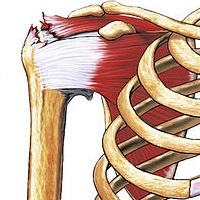
Photo from wikipedia
Background: Operative time is a risk factor for short-term complications after orthopaedic procedures; however, it has yet to be investigated as an independent risk factor for postoperative complications after arthroscopic… Click to show full abstract
Background: Operative time is a risk factor for short-term complications after orthopaedic procedures; however, it has yet to be investigated as an independent risk factor for postoperative complications after arthroscopic rotator cuff repair. Purpose: To determine whether operative time is an independent risk factor for complications, readmissions, and extended hospital stays within 30 days after arthroscopic rotator cuff repair. Study Design: Descriptive epidemiology study. Methods: The American College of Surgeons National Surgical Quality Improvement Program was queried for all hospital-based inpatient and outpatient arthroscopic rotator cuff repairs (Current Procedural Terminology code 29827) from 2005 to 2016. Concomitant procedures such as subacromial decompression, biceps tenodesis, superior labrum anterior and posterior (SLAP) repair, labral repair, and distal clavicle excision were also included, whereas patients undergoing arthroplasty were excluded from the study. Operative time was correlated with patient demographics, comorbidities, and concomitant procedures. All adverse events were correlated with operative time, while controlling for the above preoperative variables, using multivariate Poisson regression with a robust error variance. Results: A total of 27,524 procedures met inclusion and exclusion criteria. The mean age of patients was 58.4 ± 10.9 years, the mean operative time was 86.9 ± 37.4 minutes, and the mean body mass index was 30.4 ± 7.0 kg/m2. Concomitant biceps tenodesis, glenohumeral debridement, SLAP repair, labral repair, and distal clavicle excision significantly increased operative time (P < .001) but not the risk of adverse events (P > .05). The overall rate of adverse events was 0.88%. After adjusting for demographic and procedural characteristics, a 15-minute increase in operative duration was associated with an increased risk of anemia requiring transfusion (relative risk [RR], 1.27 [95% CI, 1.14-1.42]; P < .001), venous thromboembolism (RR, 1.17 [95% CI, 1.02-1.35]; P = .029), surgical site infection (RR, 1.13 [95% CI, 1.03-1.24]; P = .011), and extended length of hospital stay (RR, 1.07 [95% CI, 1.00-1.14]; P = .036). Conclusion: Although the rate of short-term complications after arthroscopic rotator cuff repair is low, incremental increases in operative time are associated with an increased risk of adverse events such as surgical site infection, pulmonary embolism, transfusion, and extended length of hospital stay. Efforts should be made to maximize surgical efficiency in the operating room through optimal coordination of the staff or increased preoperative planning.
Journal Title: Orthopaedic Journal of Sports Medicine
Year Published: 2019
Link to full text (if available)
Share on Social Media: Sign Up to like & get
recommendations!